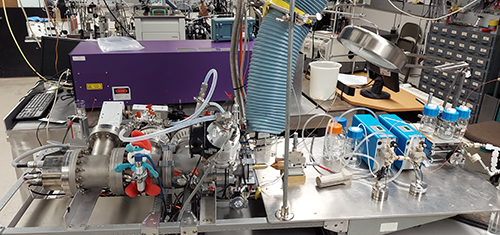Chemical Processes & Instrument Development: Instruments
Electrospray Ionization Quadrupole Mass Spectrometer (ESI-Q-MS)


Principle of the Measurement
The electrospray ion source relies on charge separation and ionization occurring in a fine spray of droplets in an intense electric field. This source can produce either positive or negative ions according to the application. These ions are then sampled into the mass spectrometer for analysis.
Technical Specifications
This instrument is based on a Balsers QM420 quadrupole mass spectrometer with a home-built front end that includes an ion funnel and octopole ion guides.
Time Response: Capable of sub 1Hz operation on single ions, but the practical time resolution for multiple ions in combination with the ESI source is 10 sec
Detection Limit: 5 x10-7 g/L Chloride ions
Accuracy: ±10% at concentrations well above detection limit for calibrated species
Applications
This instrument was interfaced with a particle-into-liquid-sampler (PiLS) for analysis of particles emitted by wildfire. It was also used in conjunction with total reactive nitrogen (Nr) and total organic carbon (TOC) methods to develop and validate aerosol particle calibration methods. Recent uses have included detection of ion species in kinetic measurements of the reaction rates of organic species with O3 in solution and reactions of cyanate ion in solution.
Key Publications
Stockwell, C.E., A. Kupc, B. Witkowski, R.K. Talukdar, Y. Liu, V. Selimovic, K.J. Zarzana, K. Sekimoto, C. Warneke, R.A. Washenfelder, R.J. Yokelson, A.M. Middlebrook, and J.M. Roberts, Characterization of a catalyst-based total nitrogen and carbon conversion technique to calibrate particle mass measurement instrumentation, Atmospheric Measurement Techniques, doi:10.5194/amt-11-2749-2018, 2018.